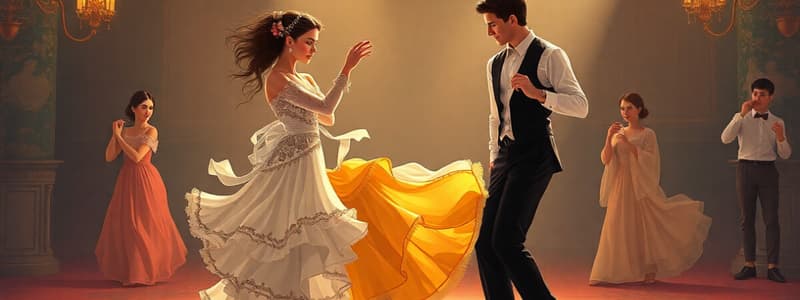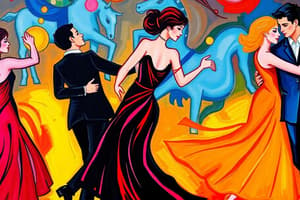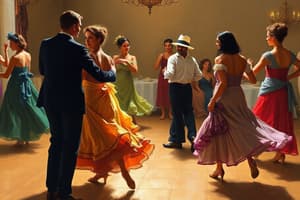Podcast
Questions and Answers
Which of the following dances is NOT classified as a Latin-American dance?
Which of the following dances is NOT classified as a Latin-American dance?
- Foxtrot (correct)
- Salsa
- Jive
- Cha-cha-cha
All Latin-American dances originated from Brazil.
All Latin-American dances originated from Brazil.
False (B)
What is the time signature of the Rumba dance?
What is the time signature of the Rumba dance?
2/4 or 4/4
The dance ____ originated from the Dominican Republic and has a time signature of 2/4.
The dance ____ originated from the Dominican Republic and has a time signature of 2/4.
Match the following dances to their origins:
Match the following dances to their origins:
Which of the following best describes the basic step pattern for men in the Cha-Cha-Cha?
Which of the following best describes the basic step pattern for men in the Cha-Cha-Cha?
The Waltz is characterized by a rhythm that is played in a quadruple time signature.
The Waltz is characterized by a rhythm that is played in a quadruple time signature.
What is the typical tempo for dancing the Waltz?
What is the typical tempo for dancing the Waltz?
The __________ is a smooth dance characterized by 'rise and fall' actions.
The __________ is a smooth dance characterized by 'rise and fall' actions.
Match the dance steps with their corresponding descriptions:
Match the dance steps with their corresponding descriptions:
What is the origin of the word 'Waltz'?
What is the origin of the word 'Waltz'?
The Basic Swing for Women involves a step pattern that includes moving to the side and backwards.
The Basic Swing for Women involves a step pattern that includes moving to the side and backwards.
Name one item of formal attire for gentlemen in social dances.
Name one item of formal attire for gentlemen in social dances.
In social dances, the attire for ladies is typically a __________.
In social dances, the attire for ladies is typically a __________.
What is the primary function of wearing dance shoes?
What is the primary function of wearing dance shoes?
Match the foot movements for the man's and lady's feet in the Right Foot Change:
Match the foot movements for the man's and lady's feet in the Right Foot Change:
No-fault dancing means blaming a partner for mixed execution of figures.
No-fault dancing means blaming a partner for mixed execution of figures.
What is the aim of personal grooming before a dance?
What is the aim of personal grooming before a dance?
During the Waltz, the gradual rise starts at the end of the first beat and continues to the __________.
During the Waltz, the gradual rise starts at the end of the first beat and continues to the __________.
Which of the following is a characteristic of the Basic Swing?
Which of the following is a characteristic of the Basic Swing?
Flashcards
Cha-cha-cha Origin
Cha-cha-cha Origin
Evolved from the Cuban Mambo, gaining popularity in the US during the 1950s.
Latin Dances Characteristics
Latin Dances Characteristics
Usually involve revealing, close-fitting, sophisticated costumes with a focus on specific movements.
Rumba Time Signature
Rumba Time Signature
Often uses 2/4 or 4/4 time signatures.
Cha-cha-cha Steps
Cha-cha-cha Steps
Signup and view all the flashcards
Swing Dance Origin
Swing Dance Origin
Signup and view all the flashcards
Waltz Popularity
Waltz Popularity
Signup and view all the flashcards
Waltz Characteristics
Waltz Characteristics
Signup and view all the flashcards
Waltz Partnering Skill
Waltz Partnering Skill
Signup and view all the flashcards
Waltz Tempo
Waltz Tempo
Signup and view all the flashcards
Waltz Origin
Waltz Origin
Signup and view all the flashcards
Waltz 'Rise and Fall'
Waltz 'Rise and Fall'
Signup and view all the flashcards
Basic Waltz Step Pattern
Basic Waltz Step Pattern
Signup and view all the flashcards
Left Foot Change in Waltz
Left Foot Change in Waltz
Signup and view all the flashcards
Right Foot Change in Waltz
Right Foot Change in Waltz
Signup and view all the flashcards
Box Waltz Step
Box Waltz Step
Signup and view all the flashcards
Waltz Forward Progressive
Waltz Forward Progressive
Signup and view all the flashcards
Waltz Whisk
Waltz Whisk
Signup and view all the flashcards
Gentlemen's Formal Attire
Gentlemen's Formal Attire
Signup and view all the flashcards
Ladies' Formal Attire
Ladies' Formal Attire
Signup and view all the flashcards
Semi-Formal Attire - Gentlemen
Semi-Formal Attire - Gentlemen
Signup and view all the flashcards
Semi-Formal Attire - Ladies
Semi-Formal Attire - Ladies
Signup and view all the flashcards
Study Notes
Social Dance Classifications
- Latin-American Dances: Originate from Latin American countries; characterized by revealing, tight-fitting costumes; dynamic movements.
- Examples: Salsa, Mambo, Merengue, Cha-cha-cha, Rumba, Samba, Paso Doble, Jive, Boogie, Swing.
- Modern Standard Dances: Performed in formal attire (anckle-length gowns for women, coats and ties for men); characterized by specific movements; include Waltz, Tango, Viennese Waltz, Foxtrot, and Quickstep.
Latin-American Dance Details
- Origins and Time Signatures: Information on the origin and time signature is provided for each dance.
Dance Mixers
- Dance Mixers: Social dances allowing performers to change partners periodically for social interaction.
Cha-Cha-Cha
- Origin: Developed from the Cuban Mambo, popularized in the 1950s.
- Characteristics: Triple chasse steps (cha-cha-cha's) and rock steps; modified Cuban hip action due to its speed.
- Steps (General Instructions): Partner selection (opposite sex); females on the right side; clapping the rhythm (4 and 1, 2, 3); following step patterns and performing basic steps; repetition for mastery.
- Detailed steps for men and women are provided.
Swing Dance
- Origin: Developed with the swing style of jazz music (1920s–1940s).
- Characteristics: Energetic, joyful dance.
- Steps (General Instructions): Partner selection (opposite sex); females on the right side; following step patterns and performing basic steps; repetition for mastery.
- Detailed steps for men and women are provided.
Modern Standard Dance: Waltz
- Overview: A type of social dance; performed in a close hold or closed position.
- Characteristics: Smooth dance characterized by rise and fall and body sway; triple time signature.
- Partnering Skills: Smooth shoulder movements (parallel to floor); head turns in direction of turn (men upright, looking over the lady's right shoulder); danced to music with 30-32 measures per minute.
- Origin: Austro-German folk dance ("Walzen" – to rotate or turn); popularized by Johann Strauss II.
Waltz: Rise and Fall
- Technique: Long steps; heel, then ball of foot on first forward step; gradual rise of toes; lowering to heel at the end of the third beat.
Basic Waltz Steps
- Step Pattern: Three counts (slow, quick, quick) repeated twice.
- Left Foot Change, Right Foot Change, Box Waltz Step, Waltz Forward Progressive, and Whisk detailed steps are provided, including both male and female footwork.
Attire for Social Dances
- Gentlemen's Attire: Formal (tailcoat, tuxedo, coat, bow tie or necktie, black trousers); Semi-Formal (dress shirt and tie, vest or sweater); Dressy Casual (solid color shirt, turtleneck, or polo shirt, cotton slacks, conservative appearance).
- Ladies' Attire: Formal (ball gown, evening gown, dinner gown, cocktail gown); Semi-Formal (dinner dresses, flowing pants); Dressy Casual (comfortable, conservative attire).
Comfort and Safety Tips
- Shoes: Wear dance shoes.
- Clothing: Avoid sleeveless shirts, strapped dresses, baggy sleeves, low-cut sleeves (Latin/Swing); be cautious with accessories.
- Grooming: Shower, use deodorant, brush teeth, abstain from strong-smelling food; check grooming, freshen up during dance; carry extra shirt (men)
Dance Etiquette
- Direction: Dance counterclockwise.
- Politeness: Thank or compliment partner; accompany partner back to their seat.
- No-Fault Dancing: Avoid blaming partner, dance to partner's level, apologize for mistakes.
- Behavior/Demeanor: Responsible, smiling, eye contact; positive image; honest refusal if unsure of the dance; refrain from teaching on the dance floor.
Studying That Suits You
Use AI to generate personalized quizzes and flashcards to suit your learning preferences.




